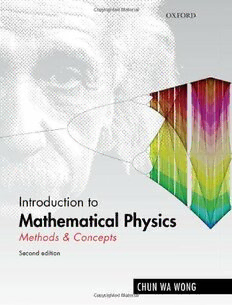Table Of ContentIntroduction to Mathematical Physics
This page intentionally left blank
Introduction to Mathematical Physics
Methods and Concepts
Second Edition
Chun Wa Wong
DepartmentofPhysicsandAstronomy
UniversityofCalifornia
LosAngeles
1
3
GreatClarendonStreet,Oxford,OX26DP,
UnitedKingdom
OxfordUniversityPressisadepartmentoftheUniversityofOxford.
ItfurtherstheUniversity’sobjectiveofexcellenceinresearch,scholarship,
andeducationbypublishingworldwide.Oxfordisaregisteredtrademarkof
OxfordUniversityPressintheUKandincertainothercountries
(cid:2)c ChunWaWong2013
Themoralrightsoftheauthorhavebeenasserted
FirstEditionpublishedin1991
SecondEditionpublishedin2013
Impression:1
Allrightsreserved.Nopartofthispublicationmaybereproduced,storedin
aretrievalsystem,ortransmitted,inanyformorbyanymeans,withoutthe
priorpermissioninwritingofOxfordUniversityPress,orasexpresslypermitted
bylaw,bylicenceorundertermsagreedwiththeappropriatereprographics
rightsorganization.Enquiriesconcerningreproductionoutsidethescopeofthe
aboveshouldbesenttotheRightsDepartment,OxfordUniversityPress,atthe
addressabove
Youmustnotcirculatethisworkinanyotherform
andyoumustimposethissameconditiononanyacquirer
BritishLibraryCataloguinginPublicationData
Dataavailable
ISBN 978–0–19–964139–0
Printedandboundby
CPIGroup(UK)Ltd,Croydon,CR04YY
Preface to the second edition
In this second edition of a book for undergraduate students of physics, two long
chaptersofmoreadvancedtopicshavebeenadded.Oneofthesechaptersdealswith
the unfolding of invariant Lorentz spacetime scalars into 4D spacetime vectors in
relativisticsquare-rootspaces.IttellsthestoryofhowHamilton’s3Dgeneralization
ofthecomplexnumber,Pauli’sspinmatrices,Dirac’srelativisticwaveequation,and
otheractors,includingspinorwavefunctionsandtensoroperators,playonEinstein’s
spacetimestagewherephysicaleventstakeplace.
The other chapter is concerned with nonlinear phenomena in physics. Nonlin-
earityhastwostrangelycontradictorypersonalities.Itcancauseirregularities,insta-
bilities, turbulence and chaos. Under other circumstances it can give rise instead to
unusualcoherenceandcollectivity.Weshallexplainhowtheseseeminglycontradic-
torymanifestationscanbeunderstoodconceptuallybyusingsometimesanalyticand
sometimesnumerictools.Theseaddedtopicsareofinteresttoadvancedundergrad-
uateandbeginninggraduatestudents.
Seven short tutorials on some basic topics of college mathematics have been
appendedforrevieworreference.Withtheall-pervasivepersonalcomputerinmany
academictoolboxes,itisnowpossibletoundertakeratherextensivenumericalcalcu-
lationsandevenformalmathematicalmanipulationsusingcomputeralgebrasystems
such as Mathematica. Two appendices on computer algebra systems in general and
Mathematicainparticularhavebeenincludedtointroducethereadertothisimportant
classoftoolsinmathematicalphysics.AsectionhasbeenaddedtodescribeInternet
resources on mathematical physics at this introductory level. The old book list and
bibliographyofthefirsteditionhavealsobeenexpanded.
I have taken this opportunity to improve and add to the text of the original
chapters and to correct the many misprints present in the first edition. Hints have
been added to many of the problems. An Instructor’s Solutions Manual is available
to instructors who have chosen the book for course adoption. I appeal to their good
will to refrain from posting this solutions manual on the Web, so that the book can
serveitseducationalpurposes.
Several readers and students have taken the trouble to call my attention to mis-
prints in the first edition. I thank them for their kindness. One of them deserves a
specialmention.L.C.Jonessentmeaparticularlylonglistofmisprintscoveringthe
firsttwochapterswhenthefirsteditionfirstcameout.
The drawings of Newton and Einstein shown in the endpapers are by the noted
ArgentineartistIuttaWaloschek.Ithankherforpermissiontousetheminthebook.
LosAngeles C.W.W.
February2012
Preface to the first edition
This book is based on lecture notes for two undergraduate courses on mathematical
methods of physics that I have given at UCLA during the past twenty years. Most
of the introductory topics in each chapter have been used at one time or another in
thesecourses.Thefirstofthesecourseswasintendedtobeabeginningjuniorcourse
tobetakenbeforethephysicscorecourses,whilethesecondwasanelectivecourse
for seniors. These courses have evolved over the years in response to the perceived
needs of a changing student population. Our junior course is now a prerequisite for
junior courses on electricity and magnetism and on quantum mechanics, but not for
thoseonanalyticmechanics.Ourelectiveseniorcourseisnowconcernedsolelywith
functionsofacomplexvariable.InthisformatIamabletocoverinonequartermost
of the easier sections of the first three chapters in our junior course, and the entire
Chapter6intheseniorcourse.Mostofourstudentsarephysicsmajors,butmanyare
from engineering and chemistry, especially in the senior course. The latter course is
alsorecommendedtoourownfirst-yeargraduatestudentswhohavenotbeenexposed
tocomplexanalysisbefore.
Theideaofteachingmathematicalphysicsasasubjectseparatefromthephysics
core courses is to help the students to appreciate the mathematical basis of physical
theoriesandtoacquiretheexpectedlevelofcompetenceinmathematicalmanipula-
tions. I believe that our courses, like similar courses in other universities, have been
quitesuccessful.Thisisnottosaythatthesecoursesareeasytoteach.Myexperience
has been that our junior course on mathematical methods of physics is one of the
most difficult undergraduate courses to teach. Several factors combine to make it so
challenging, including the diversity in the background and abilities of our students
and the large number of topics that one would like to cover. Not the least of these
factors is an adequate list of available textbooks at the right level and written in the
rightstyle.Itishopedthatthisbookwilladdressthisneed.
Each chapter in this book deals with a single subject. Chapter 1 on vectors and
fieldsinspaceisconcernedwiththevectorcalculusneededforastudyofelectricity
and magnetism. Chapter 2 on transformations, matrices and operators contains a
number of topics in algebra of special importance to the study of both classical and
quantum mechanics. It is also concerned with the general mathematical structure
of laws of physics. Chapter 3 on Fourier series and Fourier transforms prepares
the students for their study of quantum mechanics. The treatment of differential
equations in Physics in Chapter 4 covers most of the basic mathematical concepts
and analytic techniques needed to solve many equations of motion or equations
of state in physics. Special functions are covered in Chapter 5 with emphasis on
special techniques with which the properties of these functions can be extracted.
Finally, Chapter 6 on functions of a complex variable gives a detailed introduction
to complex analysis, which is so basic to the understanding of functions and their
manipulations. This chapter provides a firmer mathematical foundation to students
Prefacetothefirstedition vii
who intend to go on to graduate studies in the physical sciences. Many topics have
beenleftoutinordertohaveabookofmanageablesize.Theseincludeinfiniteseries,
tensoranalysis,probabilitytheory,thecalculusofvariations,numericalanalysisand
computermathematics.
Thestyleofwritingandthelevelofdifficultydifferindifferentchapters,andeven
in different sections of the same chapter. As a rule, the pace is more leisurely and
thederivationsaremoredetailedinthemorebasicsectionsthathavebeenusedmore
heavily.Myexperiencehasbeenthateventhemostdetailedderivationisnotadequate
for some of the students. There is really no substitute for a patient and perceptive
instructor. On the other hand, the more advanced sections have been written in a
ratherconcisestyleontheassumptionthatthereaderswhomightwanttoreadthem
canbeexpectedtobemoreexperiencedandfearless;theymightbeabletobridgeor
toleratemostofthemissingstepswithouttoomuchanguish.Concisenessmightalso
beavirtueifthebookistobeusedasareference.Itishopedthat,afterthebookhas
beenusedasatextbook,itwillremainonthebookshelfasareferencebook.
Iamgratefultothemanystudentswhohavetakenmycoursesandusedprevious
versionsofmylecturenotes.Theircriticismandsuggestionshavehelpedmeimprove
the text in numerous places. I want to thank the many teaching assistants who have
been associated with these courses for their help with problems. I want to thank
editors, reviewers and colleagues who have read or used this book for their advice
andsuggestions.Twopersonsinparticularmustnotremainunnamed.Mrs.Beatrice
Blonsky typed successive versions of this book over a period of many years; but
for her enthusiasm, this book would not have taken shape. Mr. Ron Bohm worked
wonders at the daunting task of entering the manuscript into the computer. To each
of these persons, named as well as unnamed, I want to express my deep and sincere
appreciation.
LosAngeles C.W.W
July1990
This page intentionally left blank
Contents
1 Vectorsandfieldsinspace 1
1.1 Conceptsofspace 1
1.2 Vectorsinspace 4
1.3 Permutationsymbols 14
1.4 Vectordifferentiationofascalarfield 20
1.5 Vectordifferentiationofavectorfield 25
1.6 Path-dependentscalarandvectorintegrations 31
1.7 Flux,divergenceandGauss’stheorem 42
1.8 Circulation,curlandStokes’stheorem 48
1.9 Helmholtz’stheorem 53
1.10 Orthogonalcurvilinearcoordinatesystems 56
1.11 Vectordifferentialoperatorsinorthogonalcurvilinear
coordinatesystems 65
Appendix1Tablesofmathematicalformulas 72
2 Transformations,matricesandoperators 76
2.1 Transformationsandthelawsofphysics 76
2.2 Rotationsinspace:Matrices 77
2.3 Determinantandmatrixinversion 87
2.4 Homogeneousequations 93
2.5 Thematrixeigenvalueproblem 97
2.6 Generalizedmatrixeigenvalueproblems 104
2.7 EigenvaluesandeigenvectorsofHermitianmatrices 108
2.8 Thewaveequation 114
2.9 Displacementintimeandtranslationinspace:
Infinitesimalgenerators 117
2.10 Rotationoperators 125
2.11 Matrixgroups 129
Appendix2Tablesofmathematicalformulas 135
∗
3 Relativisticsquare-rootspaces 138
3.1 Introduction 138
3.2 SpecialrelativityandLorentztransformations 139
3.3 Relativistickinematicsandthemass–energyequivalence 150
3.4 Quaternions 159
3.5 Diracequation,spinorsandmatrices 165
∗
3.6 SymmetriesoftheDiracequation 172
∗MarksanadvancedtopicinContents,oralongordifficultprobleminthechapters.

